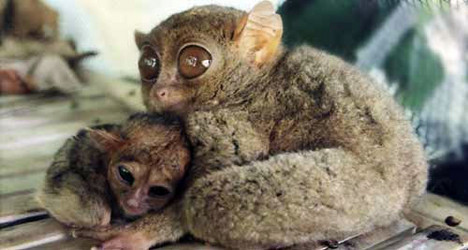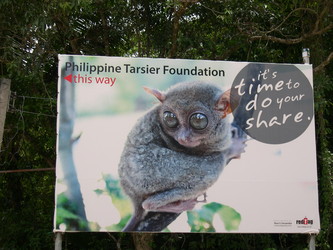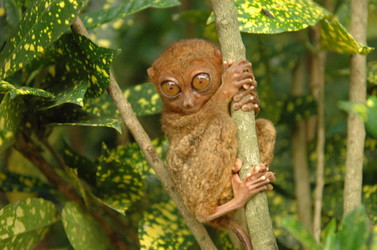Tarsius syrichta
(Philippine Tarsier)


That's a typical Philippine tarsier - we're known for our giant eyes. © 2005 Kristoffer Dominic Amora
Kumusta!
That’s how we say hello when we greet people in Filipino. My name is Taban, and I’m a Tarsius syrichta, but we all call ourselves Filipino tarsiers. I’m just a baby right now, but in a few more days I’ll be able to hunt for myself. But let me tell you a bit about myself first. I’m one of the smallest primates in the world, and if you happen to have a little brother whose hand is about eight and a half centimeters long, then you know how big I am – or should I say little? I don’t weigh very much either – barely eighty grams.
I’m usually called a funny-looking creature by most other animals, and that’s because I have the biggest eyes out of any mammal in proportion to their body. It’s kind of funny, because my mom was pregnant with me for six months, but I’m only six days old and already I can turn my head almost 180 degrees around my body. I’ve been practicing my jumping as much as possible, and in a few more days I’ll be able to jump from branch to branch, but I can’t go all that far yet, because I’m still very young. If we have to go someplace far though, my mother still carries me around by her teeth. Something I’ll never be too old for is grooming, which my mother does every day with her special digits (it’s what we call our little hands) that have claws on some and flat nails on the others. My brown fur is soft so I like to keep it clean, and it also helps us hide during the day, because we like to sleep close to the ground.
That’s something else about us that you probably didn’t know – because we are nocturnal animals, our giant eyes help to make us one of the best hunters out there. They also help us to see where we’re going, because tarsiers like to jump from branch to branch instead of walking and crawling on our legs. Well, because we are so small we can’t hunt anything too big, but we’re very good at catching insects, which is basically the only thing we eat. Insects also influence the success of our mating seasons, which start around April or May.


That's my mom and me - all mothers are very protective of their young in the first month. © Sarangani Provincial Information Office
People used to actually keep us as pets, because we can usually live for about thirteen years, but we need fresh insects to live, so it’s hard to get a proper diet in captivity. Our population numbers have been going down steadily since about twenty years ago, but the conservationist people from the ICUN that count us haven’t been able to get a proper number since 2000, so nobody really knows if we’re close to extinction, but they label us “threatened” just in case. Also, people aren’t allowed to buy or sell us anymore, and even scientists have to get permission before they can do any testing with us. It feels good to know that we have all of this protection to keep us safe, but it’s a little annoying not knowing how many of us there are. However it keeps us out of the homes of humans, and between you and me, we don’t make good pets anyways. Philippine tarsiers are very good at transfering worms and parasites to humans. Plus we are very anti-social creatures. We don’t make a lot of vocal noise; usually we urinate and use different scents to recognize each other and mark our territory. We like our peace and quiet, and we don’t like to be noticed by other animals – especially wild cats, our number one predators.


Because our exact population is unknown, the Philippine Tarsier Foundation was created to help out.
Well, that’s what life is like for me as a Tarsius syrichta. I hope you learned something about the Philippine tarsier, and please don't forget that we can't keep ourselves from going extinct; we need your help! I’d tell you more, but I am after all only six days old.
Kastan!
Characteristics
The Philippine Tarsier is one of the smallest primates in the world, standing at about 8.5 to 16 centimeters in size (imagine the hand of a five year-old), with a hairless tail that is double the length of the rest of the body. They are extremely lightweight, weighing between 80 and 165 grams. The coloring of its fur tends to be brown or gray, but there is also the possibility of reddish-brown hair. The Philippine tarsier is a bilaterally symmetrical species. The tarsier has big, bat-like ears and a round head, but what makes it easiest to recognize is its eyes, the largest of any mammal in proportion to its body. Because their eyes are fixed, they have the ability to rotate their heads 180 degrees. Coupled with extremely sensitive hearing, this makes the Philippine tarsier one of the most effective nocturnal hunters. With skinny yet powerful arms and legs that are equipped with pads on the end of their digits, a typical tarsier is capable of jumping six meters (Animal Diversity Web).
Specific Habitat
Tarsius syrichta is found in the lush rainforests of the Philippines. This species is most commonly found on Samar, Leyte, Bohol, and Mindanao. This tarsier is found in areas of tall grasses, bushes, bamboo shoots, and small trees in tropical rainforests. Like many of their primate relatives, they enjoy the canopy of the jungle; leaping from tree to tree in search of food. Tarsiers usually do not move using four limbs; instead, they have developed excellent leaping skills.
Specific Adaptations to the Environment
The tarsier has proportionally massive eyes, making their vision very acute. Coupled with their excellent hearing, this makes them superior nocturnal hunters. Similar to owls, tarsiers can rotate their heads a full 180 degrees. Tarsiers have adapted to become skilled jumpers. Many are capable of jumping up to twenty feet, an important survival skill in the jungle. Due to a diet of mostly insects, the tarsier has long flattened nails.


Our fur is perfect for blending in with the native trees of the Philippines. © 2008 Ian
Classification
- Kingdom: Animalia
- Phylum: Chordata
- Class: Mammalia
- Order: Primates
- Family: Tarsiidae
- Genus: Tarsius
- Species: Tarsius syrichta
Tarsius syrichta is a eukaryotic mammal, it falls under the kingdom of Animalia. The tarsier is a vertebrate, thus falling under the Chordata phylum.
Importance to the Ecosystem
As predators, these tiny primates help to structure insect communities. Their feeding habits help to maintain part of the insect population. Although they are elusive, the extent that they are preyed upon by other animals may impact predator populations. In relation to humans, they are sometimes kept as pets in Philippine households. There have been instances of parasites being transmitted to humans from their tarsier pets. Since the 1980s owning this animal has been prohibited due to dwindling population numbers.
Endangerment Status
The current state of T. syrichta is threatened and endangered. Captive breeding efforts have begun, but to date all have failed. Tarsiers have suffered greatly from hunters and trappers, who shake the animals out of their trees or chop down the branches of the trees in which they live. It has been reported that tarsiers are so traumatized by captivity that they beat their heads against their cages, eventually killing themselves. Philippine tarsiers are also significantly affected by the increased rate of deforestation in their native habitat.
Reproductive Characteristics
It is assumed that because tarsiers are usually seen in male-female pairings, they are a monogamous species. Mating and breeding occurs throughout the year, however the season is generally determined according to the abundance of insects. The gestation period of a tarsier is six months, and a female produces a single offspring. Most tarsiers breed twice a year. A baby tarsier can begin to climb after just two days, and can jump between branches after four. Until all of their motor skills have been fully developed, the mode of transportation used for the first nineteen days is the mouth of the mother.
Information on the Internet
- Tarsius syrichta Kubicek, C. 1999. Animal Diversity Web. Accessed September 16, 2008
- Tarsius syrichta Genome Sequencing Center. Accessed September 19, 2008
- Tarsiers: Tarsiidae - Philippine tarsier (Tarsius syrichta) Animal Life Resource Species Account. Accessed September 19, 2008
- Philippine tarsier (Tarsius syrichta) The Primata. Accessed September 19, 2008



 Go to quick links
Go to quick search
Go to navigation for this section of the ToL site
Go to detailed links for the ToL site
Go to quick links
Go to quick search
Go to navigation for this section of the ToL site
Go to detailed links for the ToL site